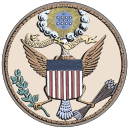 |
|
Union states in the American Civil War |
|---|
|
|
| Dual governments |
| Territories and D.C. |

At the outbreak of the American Civil War, Oregon had no organised militia and had sold most of the equipment bought for the Rogue River Wars. The state's governor, John Whiteaker, was pro-slavery and opposed to Oregon's involvement in the conflict. As such, it was only in late 1862 with a new governor that the state raised any troops: the 1st Oregon Cavalry served until June 1865.[1]
During the Civil War, emigrants to the newfound gold fields in Idaho and Oregon continued to clash with the Paiute, Shoshone and Bannock tribes of Oregon, Idaho and Nevada until relations degenerated into the bloody 1864–1868 Snake War. The 1st Oregon Volunteer Infantry Regiment was formed in 1864 and its last company was mustered out of service in July 1867. Both units were used to guard travel routes and Indian reservations, escort emigrant wagon trains, and protect settlers from Indian raiders. Several infantry detachments also accompanied survey parties and built roads in central and southern Oregon.[2]
Oregon's second United States Senator, Col. Edward Dickinson Baker was killed while leading Union troops at the Battle of Ball's Bluff near Leesburg, Virginia on October 21, 1861. His death in battle occurred exactly one month after another Oregonian, Captain James W. Lingenfelter of Company B, 71st Pennsylvania Infantry Regiment, was killed while on the picket line. In civilian life, Captain Lingenfelter had been a practicing attorney in Jacksonville, Oregon. He had been visiting in the East when the war started and enlisted to serve with Colonel Baker.
- ^ McArthur, Scott (2014). The Enemy Never Came: The Civil War in the Pacific Northwest. Caxton Press., Kindle locations 743, 753, 761
- ^ Edwards, Glenn Thomas, Oregon Regiments in the Civil War Years: Duty on the Indian Frontier, unpublished Master of Arts thesis, Department of History, University of Oregon, Eugene, Oregon, June 1960.